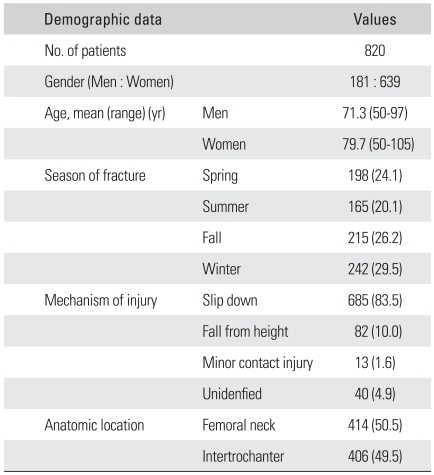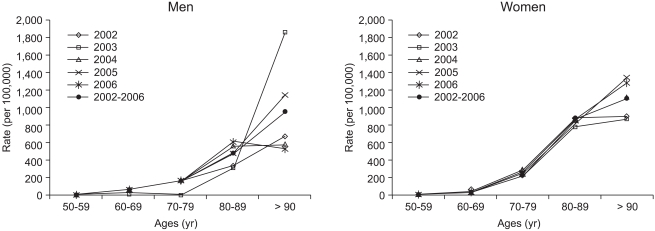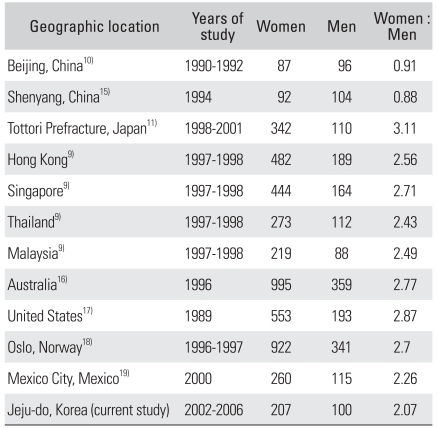Abstract
Background
This study was perfomed to estimate the incidence of hip fractures of people older than 50 years in South Korea.
Methods
Information of patients over 50 years of age who had sustained a hip fracture were obtained from the records of eight hospitals in Jeju Island between 2002 and 2006 to calculate the incidence of hip fractures in this age group.
Results
There were 820 hip fractures during the study period. The mean age of the patients at the time of fracture was 77.8 years (71.3 years in 181 men, 79.7 years in 639 women). The crude incidence was 128/100,000 (66.1/100,000 in men, 174.4/100,000 in women). The age-specific incidence according to the 10-year age groups increased from 19.3/100,000 for those 50 to 59 years of age to 1,095.4/100,000 for those over 90 years of age (18.9/100,000-960.4/100,000 in men and 19.7/100,000-1112.1/100,000 in women). The standardized incidence of hip fracture to the Caucasian population in the United States in 1990 was 100/100,000 for men and 207/100,000 for women.
Go to : 
Hip fractures are associated with a high risk of morbidity and mortality.1-4) The medical expenses of hip fractures are considerably greater than those of other fractures.3,4)
Previous studies reported significant increases in the incidence of hip fractures with aging.5,6) Between 1998 and 2002, the average lifespan of South Koreans increased from 74.8 years (71.1 years in men, 78.5 years in women) to 77.0 years (73.4 years in men, 80.4 years in women).7) In South Korea, there were 3.7 million people (7.9% of the general population) aged 65 or over in 2002.7) Although the increase in the general population between 1998 and 2002 was 3.2%, the population of people older than 65 years increased 27.7% during the same period. Therefore, Korean society is expected to become an aged society (population older than 65 years > 14% of the general population) by 2019.7)
A worldwide survey reported 1.7 million hip fractures in 1990.8) It is estimated that in 2050, approximately 50% of all hip fractures in the world will occur in Asia, which will become a serious socioeconomic problem, particularly for developing countries in Asia.7)
There are several reports on the incidence of hip fractures in Asian countries,9-13) which would be useful in planning preventive and therapeutic strategies in the future. This study examined the annual incidence, gender difference, season variation and injury mechanism of hip fractures in Jeju Island over the last 5 years.
Jeju Island is the largest island of Korea and is located southwest of the Korean peninsula, at longitude 126°08'-126°58' N and latitude 36°06'-33°00' E with a total area of 1,845.60 km2. The island has a mild subtropical climate with four distinct seasons. The mean temperature and annual precipitation is 16℃ and 1,564 mm, respectively. The population in 2006 was 558,496.
There are eight hospitals (one university hospital and seven general hospitals) that have an orthopedic department and emergency admission facilities. The medical records and radiography of the eight hospitals between January 2002 and December 2006 were reviewed to identify patients with hip fractures.
Patients who met the diagnostic criteria of femoral neck and intertrochanteric fractures of the International Classification of Diseases 10th revision (ICD-10: S720 and S721) and were older than 50 years at the time of the fracture were recruited. The exclusion criteria were: nonresidents of Jeju Island, fractures of pathologic bone (e.g. metastasis), isolated fractures of the greater or lesser trochanter, and fractures of the subtrochanteric region due to high energy injuries.
The patients' age, gender, the season of injury and fracture mechanism were analyzed. The denominator to calculate the fracture incidence was the mid-year population of each year (the population at July 1 of each year). The resident population data, which is released annually by the Korea National Statistical Office, was used to calculate the mid-year population, which was the mean of two populations of two consecutive years. For example, the mid-year population of Jeju Island in 2002 was the registered population in 2001 + the registered population in 2002/2. The age-standardized incidence is the weighted average of the age-specific incidence by the proportion of people in the corresponding age groups of a standard population, which is the estimated Caucasian population in the United States on July 1, 1990.14) The data was analyzed using SPSS ver. 12.0 (SPSS Inc., Chicago, IL, USA).
Go to : 
The total population of people in Jeju Island older than 50 years of age during the five years from 1998 to 2002, was 646,021 (120,022 in 2002, 123,472 in 2003, 127,168 in 2004, 134,978 in 2005, and 140,381 in 2006). There were 820 hip fractures; 414 femoral neck fractures (50.5%) and 406 intertrochanteric fractures (49.5%) in 181 men and 639 women. The mean age of the patients was 77.8 years (71.3 years in men [range, 50 to 97 years] and 79.7 years in women [range, 50 to 105 years]). The fractures occurred in 242 (29.5%), 215 (26.2%), 198 (24.1%), and 165 (20.1%) patients during winter, autumn, spring and summer, respectively. The mechanisms of injury were a slip down (685 fractures, 83.5%), fall from a height (82 fractures, 10.0%) and minor contact injury (13 fractures, 1.6%). The mechanism was not identified in the remaining 40 fractures (4.9%) (Table 1).
The crude incidence of hip fracture in the total population over 50 years of age during the five year period was 128.0/100,000. The gender-specific incidence was 66.1/100,000 in men and 174.4/100,000 in women. The annual incidence in men was 71.3/100,000 in 2002 and 70.1/100,000 in 2006. In women, the incidence was 165.4/100,000 in 2002 and 181.2/100,000 in 2006 (Table 2). The age-specific incidence for the 10-year age groups increased from 19.3/100,000 for those 50 to 59 years of age to 1,095.4/100,000 for those over-90 years of age; from 18.9/100,000 to 960.4/100,000 in men and from 19.7/100,000 to 1,112.1/100,000 in women for the respective age groups (Fig. 1). The fracture incidence of the population aged 50 years or older standardized to a Caucasian population in the United States in 1990 was 100/100,000 for men and 207/100,000 for women (Table 3).
Go to : 
Hip fractures are a significant socioeconomic burden in Asian countries. However, there are only a small number of reports on the incidence of hip fractures in the Asian population.9-13) To our knowledge, this is the first prospective epidemiologic study that has evaluated the incidence of hip fractures over a five year period in South Korea. Jeju Island is geographically isolated from the Korean peninsula and patients with hip fractures typically require hospitalization. This makes an evaluation easier and much reliable than other types of fractures. However, occasionally, some cases may be missed due to incorrect coding. All hospitals in the area were included in the study and all patient data including medical records and radiography could be reviewed. It is believed that there were only a small number of missed patients in this study.
Although the number of hip fractures decreased in 2003, the overall incidence of hip fractures increased over the five year period. Furthermore, the rates of hip fractures in both genders increased substantially in the 70 year- and older group. This concurs with the trends reported in previous studies.5,6,20,21)
The rate of hip fractures in South Korea is similar to reports from population-based studies in South East Asia (Thailand and Malaysia) and Mexico.9,19) It is lower than the rates from other advanced Asian countries (Japan, Hong Kong, and Singapore), Norway, Australia, and the United States, but higher than the rates reported in China (Table 3).9-11,15,17,18) It is expected that the rate of hip fractures in Korea will increase in the near future because Korea has the highest growth rate of aged people in the world.21-23)
In this study, the age-adjusted incidence of hip fractures in women was 2.07 times higher than in men. The gender difference in the hip fracture rate was smaller than the differences reported from other countries except for China (Table 3).10,15)
In this study, hip fractures occurred more frequently in winter and fall than in spring and summer. This seasonal variation might be explained by a variety of factors, such as the presence of ice and snow and the decreased hours of daylight and sun exposure during winter.24-26)
In this study, 85.1% of hip fractures were caused by low-energy trauma including slip down and minor injury, which suggests that hip fractures in people aged 50 years or over might be related to osteoporosis.1,25)
This study had some limitations. The population of Jeju island comprises only 1.1% of the total registered population of South Korea. Therefore, this data might not represent the precise features of hip fractures in South Korea. In order to overcome this limitation of a small cohort, the epidemiologic data was evaluated prospectively over a 5 year period.
A previous study reported the incidence of hip fractures in Gwangju City and Jeollanam-do, South Korea.12) The subjects were patients aged 50 years or older who sustained a fracture of the hip in the year 2001. The fracture incidence in that case was 133/100,000, which was similar to the average incidence of 128/100,000 found in the present study.
This study showed a tendency for an annual increase in the incidence of hip fractures particularly in women, which may lead to a serious socioeconomic problem in the near future in South Korea because South Korea is expected to be an aged society by 2019. To prepare policies to overcome this problem, programs including implementation strategies for detecting populations at risk as well as primary and secondary prevention will be necessary.
Go to : 
References
1. Randell AG, Nguyen TV, Bhalerao N, Silverman SL, Sambrook PN, Eisman JA. Deterioration in quality of life following hip fracture: a prospective study. Osteoporos Int. 2000; 11(5):460–466. PMID: 10912850.

2. Mullen JO, Mullen NL. Hip fracture mortality: a prospective, multifactorial study to predict and minimize death risk. Clin Orthop Relat Res. 1992; (280):214–222. PMID: 1611747.
3. Lippuner K, Golder M, Greiner R. Epidemiology and direct medical costs of osteoporotic fractures in men and women in Switzerland. Osteoporos Int. 2005; 16(Suppl 2):S8–S17. PMID: 15378232.

5. Finsen V, Johnsen LG, Trano G, Hansen B, Sneve KS. Hip fracture incidence in central norway: a followup study. Clin Orthop Relat Res. 2004; (419):173–178. PMID: 15021150.
6. Melton LJ 3rd. Epidemiology of hip fractures: implications of the exponential increase with age. Bone. 1996; 18(3 Suppl):121S–125S. PMID: 8777076.

7. STAT-Korea [Internet]. Korea National Statistical Office. cited 2008 Mar 25. Daejeon: Korea National Statistical Office;Available from:
http://kostat.go.kr/.
8. Cooper C, Campion G, Melton LJ 3rd. Hip fractures in the elderly: a world-wide projection. Osteoporos Int. 1992; 2(6):285–289. PMID: 1421796.

9. Lau EM, Lee JK, Suriwongpaisal P, et al. The incidence of hip fracture in four Asian countries: the Asian Osteoporosis Study (AOS). Osteoporos Int. 2001; 12(3):239–243. PMID: 11315243.

10. Xu L, Lu A, Zhao X, Chen X, Cummings SR. Very low rates of hip fracture in Beijing, People's Republic of China the Beijing Osteoporosis Project. Am J Epidemiol. 1996; 144(9):901–907. PMID: 8890668.
11. Hagino H, Katagiri H, Okano T, Yamamoto K, Teshima R. Increasing incidence of hip fracture in Tottori Prefecture, Japan: trend from 1986 to 2001. Osteoporos Int. 2005; 16(12):1963–1968. PMID: 16133645.

12. Rowe SM, Song EK, Kim JS, et al. Rising incidence of hip fracture in Gwangju city and Chonnam province, Korea. J Korean Med Sci. 2005; 20(4):655–658. PMID: 16100460.

13. Rowe SM, Yoon TR, Ryang DH. An epidemiological study of hip fracture in Honam, Korea. Int Orthop. 1993; 17(3):139–143. PMID: 8340166.

14. 1990 Census of population: general population characteristics (CP-1) [Internet]. U. S. Census Bureau. citied 2008 Mar 25. Washington (DC): U. S. Census Bureau;Available from:
http://www.census.gov/prod/cen1990/cp1/cp-1.html.
15. Yan L, Zhou B, Prentice A, Wang X, Golden MH. Epidemiological study of hip fracture in Shenyang, People's Republic of China. Bone. 1999; 24(2):151–155. PMID: 9951786.

16. Sanders KM, Seeman E, Ugoni AM, et al. Age- and gender-specific rate of fractures in Australia: a population-based study. Osteoporos Int. 1999; 10(3):240–247. PMID: 10525717.

17. Ho SC, Bacon WE, Harris T, Looker A, Maggi S. Hip fracture rates in Hong Kong and the United States, 1988 through 1989. Am J Public Health. 1993; 83(5):694–697. PMID: 8484451.

18. Lofthus CM, Osnes EK, Falch JA, et al. Epidemiology of hip fractures in Oslo, Norway. Bone. 2001; 29(5):413–418. PMID: 11704490.

19. Clark P, Lavielle P, Franco-Marina F, et al. Incidence rates and life-time risk of hip fractures in Mexicans over 50 years of age: a population-based study. Osteoporos Int. 2005; 16(12):2025–2030. PMID: 16133641.
20. Schwartz AV, Kelsey JL, Maggi S, et al. International variation in the incidence of hip fractures: cross-national project on osteoporosis for the World Health Organization Program for Research on Aging. Osteoporos Int. 1999; 9(3):242–253. PMID: 10450414.

21. Ismail AA, Pye SR, Cockerill WC, et al. Incidence of limb fracture across Europe: results from the European Prospective Osteoporosis Study (EPOS). Osteoporos Int. 2002; 13(7):565–571. PMID: 12111017.
22. Lauderdale DS, Jacobsen SJ, Furner SE, Levy PS, Brody JA, Goldberg J. Hip fracture incidence among elderly Asian-American populations. Am J Epidemiol. 1997; 146(6):502–509. PMID: 9290511.

23. Gullberg B, Johnell O, Kanis JA. World-wide projections for hip fracture. Osteoporos Int. 1997; 7(5):407–413. PMID: 9425497.

24. Lin HC, Xiraxagar S. Seasonality of hip fractures and estimates of season-attributable effects: a multivariate ARIMA analysis of population-based data. Osteoporos Int. 2006; 17(6):795–806. PMID: 16491320.

25. Mirchandani S, Aharonoff GB, Hiebert R, Capla EL, Zuckerman JD, Koval KJ. The effects of weather and seasonality on hip fracture incidence in older adults. Orthopedics. 2005; 28(2):149–155. PMID: 15751369.

26. Crawford JR, Parker MJ. Seasonal variation of proximal femoral fractures in the United Kingdom. Injury. 2003; 34(3):223–225. PMID: 12623255.

Go to : 




 PDF
PDF ePub
ePub Citation
Citation Print
Print






 XML Download
XML Download